Are you ready to embark on the rewarding journey of learning how to crate train a beagle puppy? With the right guidance and our 17-step guide, you’ll have a well-adjusted, crate-trained beagle in no time! Crate training provides a safe, secure space for your beagle, helps establish a routine, and ultimately leads to a happier, well-behaved dog.
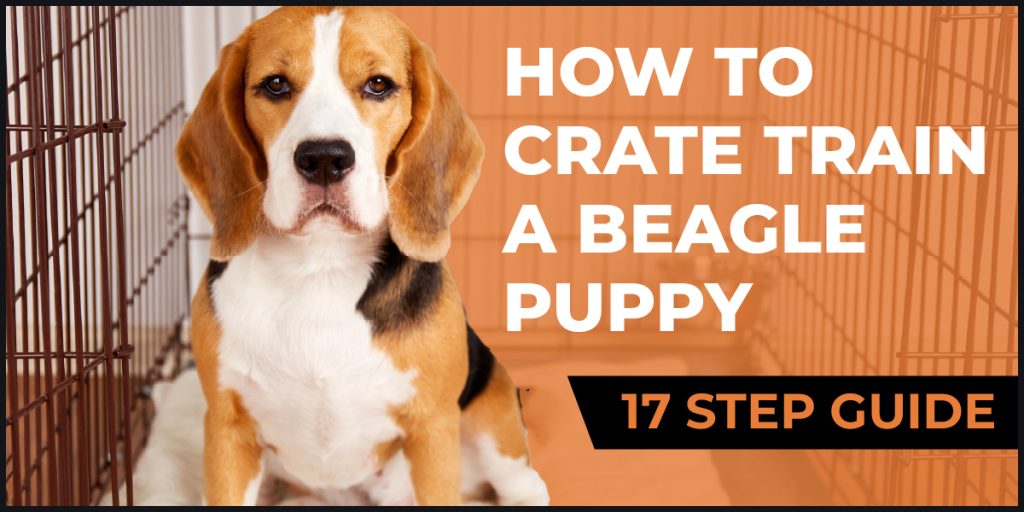 Key Takeaways
Key Takeaways
- Choose the right crate and create a welcoming atmosphere for successful beagle puppy crate training.
- Use positive reinforcement to build trust with your beagle, including regular meals in the crate.
- Establish consistency through gradual extension of time spent in the crate and commands to refine behaviors.
Find out how to train your beagle to be the well-behaved pup you desire – Read Free Report
The 17-Step Guide to Crate Training Your Beagle Puppy
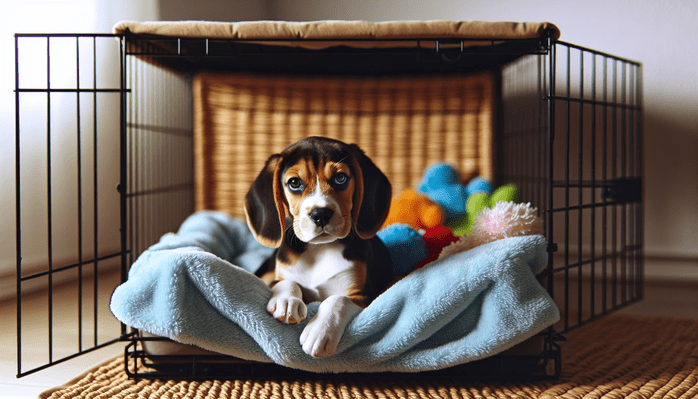
Image created with AI
The initial step in crate training your beagle puppy begins with choosing the right crate for your beagle puppies. This selection is pivotal since it aids in potty training your beagle pup and furnishing them with a safe and cozy space.
Given the playful and mischievous nature of beagles, crate training becomes a fundamental part of their upbringing. For successful crate training, it’s necessary to select an appropriate crate, find the perfect location for it, and create a welcoming atmosphere within it.
Step 1: Selecting the Perfect Crate
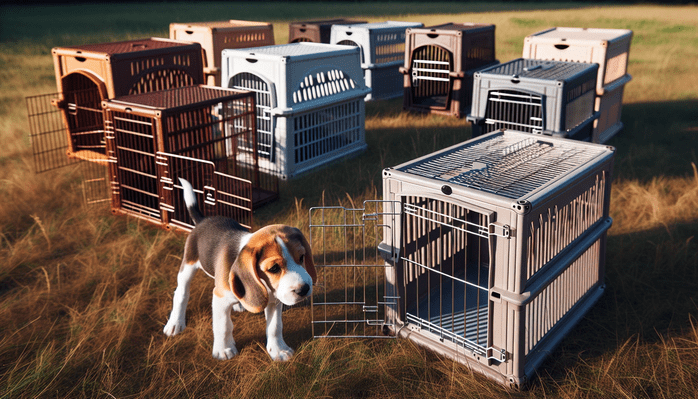
Image created with AI
While choosing your beagle dog crates, take into account aspects like size, material, and ventilation. The crate should be small enough to prevent your beagle from eliminating in one corner and resting in another, yet large enough for them to stand up and move comfortably. Typically, a crate that is 25-30 inches wide is suitable for a beagle puppy.
Ensure the crate has adequate ventilation and is made from a sturdy material that can withstand your beagle’s curiosity and energy. Don’t forget to check the crate door for durability and ease of use, especially when you need to have the crate door open.
The Best Spot for Your Beagle's Crate
The placement of your beagle’s crate holds equal importance. Place the crate in a quiet corner of the most frequented room in your home. This allows your beagle to feel included in family activities while still having their own confined space. Avoid areas with direct sunlight or drafts, as these can lead to discomfort for your beagle.
Be mindful of the temperature in the room, ensuring it stays between 20°C / 69°F (winter) and 26°C / 78°F (summer) for your beagle’s comfort.
Step 2: Making the Crate an Inviting Space

Image created with AI
To render the crate appealing, equip it with soft blanket or bedding, toys, and treats. Non-slip bed pads or VetBeds with a small blanket on top are recommended for a beagle puppy’s crate. Durable chew toys can keep your beagle entertained and help create a positive association with the crate.
Providing meals inside the crate can also foster a positive connection and make the crate feel like a welcoming environment for your beagle.
Step 3: Introducing Your Beagle Puppy to Their New Crate
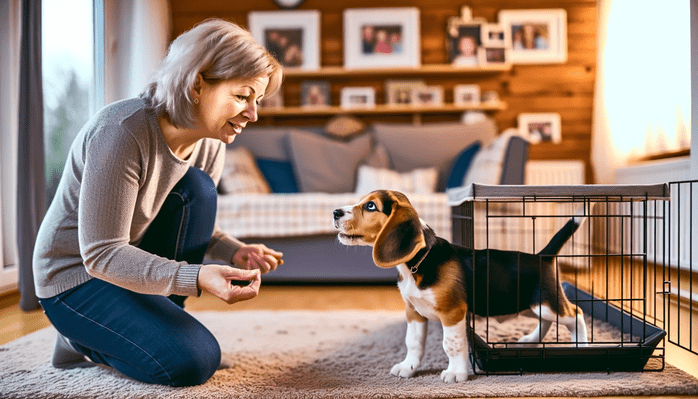
Image created with AI
Acclimating your beagle puppy to their crate demands patience and positive reinforcement. Ensuring the initial experience is positive will set the stage for successful crate training. One of the beagle training tricks is creating a positive environment, using positive reinforcement, and developing trust through crate games are necessary.
Step 4: First Impressions Matter
When introducing beagles to the crate, follow these steps:
- Make the first encounter a rewarding experience with treats and praise.
- Place treats near the door of the crate and gradually move them inside to entice your puppy to enter.
- Remember to be patient and consistent, allowing your beagle to explore the crate at their own pace.
Step 5: Positive Reinforcement Wins
Encourage your beagle to enter and remain in the crate using positive reinforcement techniques, such as praise, affection, and treats for good behavior. Reward your beagle for entering the crate voluntarily and for remaining calm once inside. This will help establish a positive connection with the crate and make it an enjoyable personal space for your puppy.
Step 6: Building Trust with Crate Games
Building trust with your beagle is essential for successful crate training. Utilize crate games to create a positive association with the crate, such as hiding treats or toys inside the crate or throwing a ball inside for your beagle to fetch. These games will help your beagle feel more comfortable and secure in their crate, fostering a strong bond between you and your puppy.
Step 7: Establishing a Crate Training Routine
Setting up a steady crate training routine is significant for your beagle’s success. Integrating mealtime, ensuring consistency, and gradually extending crate time will help create a structured routine that benefits both you and your beagle.
Step 8: Mealtime Inside the Crate
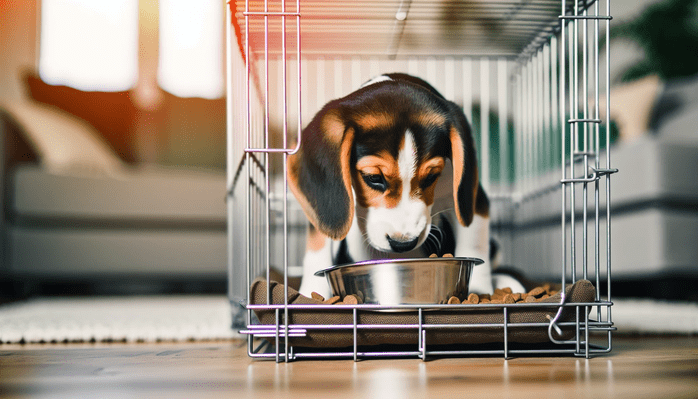
Image created with AI
Providing meals to your beagle puppy inside the crate forms a positive connection and assists with potty training. Here’s how to do it:
- Place their food bowl inside the crate.
- Leave the door open to prevent them from feeling trapped.
- This will not only make the crate a more enjoyable space but also help establish a consistent routine for mealtimes and crate use.
Consistency is Key
Keeping consistency in crate training sessions is critical for beagles to have success. Keep to a regular schedule for crate use, potty breaks, and playtime, ensuring your beagle understands what to expect each day.
Consistency in crate training beagles will lead to a well-adjusted beagle that feels comfortable and secure in their dog crate environment.
Step 9: Gradually Extend Crate Time
Initiate crate training for your beagle by following these steps:
- Keep your beagles in the crate for brief periods and slowly extend the duration as they grow more comfortable.
- This will help your beagle associate the crate with positive experiences and understand that being in their crate for brief intervals is a normal part of their day.
- Patience and consistency are essential in helping your beagle adjust to extended crate time.
Step 10: Managing Potty Training Alongside Crate Training
Crate training and potty training work together for a well-rounded beagle. Identifying potty signals, planning potty breaks, and managing accidents are vital aspects of handling potty training in conjunction with crate training. Learning how to potty train your beagle effectively is essential for a happy and healthy relationship with your pet.
Step 11: Recognizing Potty Signals
Learning to recognize your beagle’s potty signals is crucial for successful potty training. Typical indications that your beagle needs to eliminate include sniffing the floor and circling. By observing your beagle’s behavior and attending to their needs promptly, you can prevent accidents and reinforce proper potty training techniques.
Step 12: Scheduling Potty Breaks
Schedule regular potty breaks during crate training to ensure your beagle has ample opportunities to relieve themselves outside. An 8-week-old beagle puppy should be taken out for potty breaks approximately every 30 minutes while they are awake. As your puppy gets older, you can gradually increase the time between potty breaks, ensuring they have a consistent routine for elimination.
Dealing with Accidents
Accidents occur, and prompt and thorough cleanup is necessary when your beagle puppy has an accident in their crate. Use an odor neutralizer to clean the crate and wash any soiled bedding.
Maintaining a clean and odor-free environment is crucial to avoiding future accidents and ensuring your beagle feels comfortable in their crate.
Step 13: Tackling Separation Anxiety with Crate Training
Separation anxiety is a typical issue among beagles, but crate training can provide a solution for this problem. By understanding your beagle’s anxiety, creating calm departures, and increasing alone time gradually, you can help your beagle feel secure and comfortable in their crate.
Understanding Your Beagle's Anxiety
Recognizing the signs and causes of separation anxiety is the first step in addressing this issue. Beagles with separation anxiety may demonstrate behaviors such as destruction, excessive vocalization, and reluctance to go outside. By understanding the underlying reasons for your beagle’s anxiety, you can take steps to alleviate their stress and help them feel more at ease in their crate.
Step 14: Creating Calm Departures
Ensure calm departures and arrivals to reduce anxiety in your beagle. When leaving, follow these steps:
- Avoid making a big fuss or drawing attention to your departure, as this can exacerbate your beagle’s anxiety.
- Maintain a calm demeanor and provide your beagle with a treat or toy to distract them as you leave.
- This will help reduce their stress and create a more positive association with your departure.
Step 15: Increasing Alone Time Gradually
Gradually increasing the amount of time your beagle spends alone in their crate will help them adjust to being separated from you. Here’s how you can do it:
- Start by leaving them in the crate for short periods while you remain in view.
- Gradually increase the duration as they become more comfortable.
- This helps your beagle associate the crate with a secure and positive environment, ultimately reducing their separation anxiety.
Addressing Common Crate Training Challenges
Crate training a beagle puppy is not without its challenges, but with patience and consistency, you can overcome these obstacles. In this section, we’ll address common crate training challenges such as reluctance, vocal discontent, and transitioning from crate training.
When Your Beagle Remains Reluctant
If your beagle remains reluctant to enter their crate, it’s important to be patient and consistent in your approach. Utilize the following strategies to encourage them to enter the crate:
- Use treats: Place treats inside the crate to create a positive association.
- Use toys: Place your beagle’s favorite toys inside the crate to make it more inviting.
- Positive reinforcement: Praise and reward your beagle when they enter the crate voluntarily. Remember that crate training can be a lengthy process, and it may take several weeks for your beagle to become comfortable with their crate. Persistence is key.
Step 16: Handling Vocal Discontent
Barking and whining can be common challenges when crate training a beagle puppy. To address this issue, utilize the following strategies:
- Use positive reinforcement and rewards when your beagle is quiet in the crate.
- Be consistent in your training and reinforce calm behavior.
- Ignore vocal discontent and avoid giving attention to barking or whining.
By implementing these strategies, you can effectively crate train your beagle puppy and reduce barking and whining behavior.
Over time, your beagle will learn to associate the crate with a quiet, relaxed environment.
Step 17: Transitioning from Crate Training
Once your adult beagle is well-adjusted and comfortable in their crate, it’s time to transition away from crate training. Gradually increase the amount of time your beagle spends outside of the crate, ensuring they have ample opportunities for exercise and mental stimulation.
By maintaining consistent training and addressing any challenges that may arise, your adult dog, a beagle, will continue to thrive beyond crate training.
Guide Recap: How to Crate Train Your Beagle Puppy
Having covered the basics, we can now move on to our detailed 17-step guide for crate training your beagle puppies. By adhering to these steps, you’ll soon have a well-adjusted, crate-trained beagle.
Preparing the Crate
Steps 1 – 3: Select the perfect crate for your beagle puppy, considering factors such as size, material, and ventilation. Remember that the crate should be small enough to discourage elimination in one corner while providing enough space for your beagle to stand and move comfortably. Choose the best spot for your beagle’s crate, placing it in a quiet corner of the most frequented room in your home. Avoid direct sunlight, drafts, and high-traffic areas to ensure your beagle’s comfort and security.
Introducing the Crate
Steps 4 – 6: Introduce your beagles to the crate using positive reinforcement. Place treats near the door of the crate and gradually move them inside to entice your puppy to enter. Be patient and consistent, allowing your beagle to explore the crate at their own pace. Utilize crate games to create a positive association with the crate. Hide treats or toys inside the crate or throw a ball inside for your beagle to fetch. These games will help your beagle feel more comfortable and secure in their crate while building trust between you and your puppy.
Expanding Crate Time
Steps 7-9: Gradually extend crate time and establish a consistent routine. Here’s how: Feed your beagle inside the crate to create a positive association. Maintain consistency in crate training sessions. Gradually increase the amount of time your beagle spends in the crate.
This will help your beagle understand that being in their crate for brief intervals is a normal part of their day.
Nighttime Training
Steps 10-12: Implement nighttime crate training by ensuring your beagle is comfortable in their crate during the night. Manage potty breaks by establishing an alarm for regular nighttime potty breaks and creating a consistent routine for meals, playtime, and bathroom breaks.
Refining Behaviors
Steps 13-15: Start crate training by refining crate behaviors, introducing command words, and reinforcing positive behavior. Use a command word, such as ‘crate’, to encourage your beagle to enter the crate. Practice repetition and consistency in the training process, similar to potty training.
Final Touches
Steps 16-17: Maintain consistency in crate training and address any challenges that may arise during the training process. Be patient, persistent, and utilize positive reinforcement to ensure a successful crate training experience for your beagle.
Summary
Crate training beagle puppies is an essential aspect of their upbringing, providing a secure space and helping establish a routine. By following our 17-step guide and addressing common crate training challenges, you’ll have a well-adjusted, crate-trained beagle in no time. Remember, patience, consistency, and positive reinforcement are the keys to successful crate training!
Frequently Asked Questions
How to train beagles?
Early socialization and establishing a consistent schedule are essential for successful Beagle training. Positive reinforcement is key when teaching basic commands such as sit, stay, come, and leave it. Practicing redirection techniques can help to reduce excessive barking.
Are beagles easy to train?
Beagles are one of the harder breeds to train, due to their nature as a scent hound and their tendency to be independent. First-time dog owners may find Beagles particularly challenging to train.
What size crate for a beagle?
For a Beagle, the ideal crate size is 36” in length. This will ensure your pup has enough room to grow into adulthood and a double door dog crate such as the Large 36” Lords & Labradors deluxe dog crate is recommended.
How can I encourage my beagle puppy to enter their crate?
Reward your beagle puppy with treats, toys, and verbal praise when they enter their crate to encourage them to enter more often.
How long does it typically take to crate train a beagle puppy?
Crate training a beagle puppy typically takes several weeks, depending on the pup's temperament and the trainer's consistency.
Learn how to train your beagle to be the well-behaved dog you desire –> Access our Free Report
Shop for beagle-themed products and gifts that beagle enthusiasts will love.
